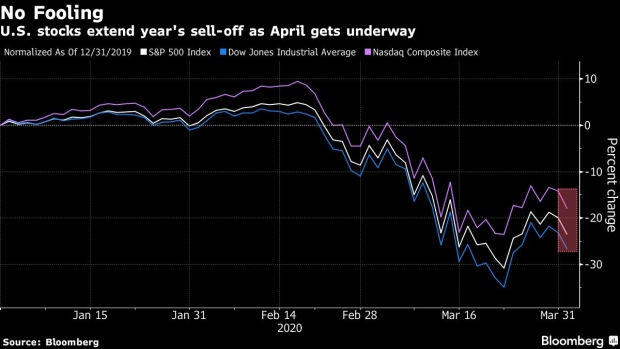Apr 1, 2020
U.S. Stock Futures Rise After S&P 500’s Worst Drop in Two Weeks
, Bloomberg News

(Bloomberg) -- U.S. stock futures rose after the S&P 500 had its biggest decline in two weeks, with investors assessing the pandemic’s impact on the slowing American economy.
Contracts on the S&P 500 rose 0.5% to 2,460 as of 6:01 p.m. in New York. The underlying gauge sank 4.4% during the regular session. It plunged 20% in the first three months of the year, the most sine 2008.
Stocks started the second quarter under pressure on news that the virus is rapidly advancing in the U.S. and likely to have a devastating effect on lives and livelihoods. The damage will mandate large-scale shutdowns remain in place for longer periods than had been anticipated, forcing widespread layoffs and rekindling concern that the worst of the stock rout is not over.
“What doesn’t seem to be trading in the market is just how bad it’s going to get in the economy,” said Jason Thomas, chief economist at AssetMark. “We don’t know how to incorporate what’s happening because it’s happening so rapidly.”
Data Tuesday showed employment at U.S. firms declined in March for the first time since 2017, as sweeping closures at small businesses began to take their toll on workers. Initial jobless claims, a more timely labor-market barometer, are due for release Thursday and projected to show filings topped 3 million for a second straight week.
Just a few days ago, it seemed all people wanted to talk about in the stock market was the sturdiness of the bottom set March 23. Now, a two-day rout of 6% has ushered back volatility that gripped markets for most of the past two months. Cboe’s fear gauge spiked back to 57 after falling toward 50 on Tuesday.
Should the swings persist during the futures session, exchange-mandated barriers that limit losses or gains to 5% will come into play. Based on a reference price calculated during the final 30 seconds of trading, the lower buffer is 2,335 and the upper bar is 2,582.
The S&P 500 fell as much as 34% from its Feb. 19 record before the government spending bill sparked a three-day rally of 18%. Strategists at JPMorgan Chase & Co. were are among those who said the worst was likely over at that point. Peers at Morgan Stanley said the S&P 500 won’t be testing lows any time soon. Now that level, set eight sessions ago, is just 10% away.
Sentiment soured Tuesday night as U.S. officials gave sobering assessments of the pandemic’s potential impact on lives and the economy. President Donald Trump warned of a “painful” upcoming period for the country, while New York Governor Andrew Cuomo said a model showed the Covid-19 outbreak may not peak in the state until the end of April.
“It’s going to be tough for a sustained rally or stability while the spread of the virus is accelerating and you keep seeing every day is worse than the last,” said Bryce Doty, senior portfolio manager at Sit Investment Associates Inc.
©2020 Bloomberg L.P.